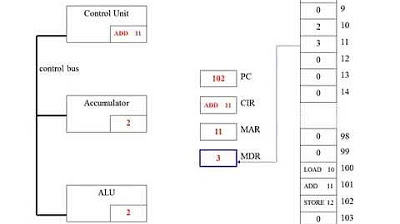Animated Fetch-Decode-Execute (FDE) Cycle for GCSE Computer Science
Summary
TLDRThis video provides a detailed breakdown of the fetch-decode-execute cycle in a CPU, using an old Flash animation to visualize the process. It walks through how instructions are fetched from memory, decoded, and executed step by step, focusing on key components like the program counter, memory address register, accumulator, and arithmetic logic unit. The video simplifies these complex operations, showing how data is moved, stored, and manipulated inside the CPU, helping viewers understand the core functions that drive computer processing.
Takeaways
- 😀 The Fetch-Decode-Execute cycle is the core process of how a CPU carries out instructions.
- 😀 The script uses an old Flash animation to visually demonstrate the cycle, though Flash is no longer supported.
- 😀 The CPU contains several key components: Control Unit, Arithmetic Logic Unit (ALU), Accumulator, and various registers like the Program Counter (PC) and Memory Address Register (MAR).
- 😀 Memory holds instructions and data, with memory addresses being numbered sequentially (1, 2, 3, etc.).
- 😀 The CPU fetches instructions from memory, starting from the Program Counter (PC), and then loads them into the Memory Address Register (MAR).
- 😀 The instruction fetched is stored in the Memory Data Register (MDR) before being moved into the Current Instruction Register (CIR) for decoding.
- 😀 The Control Unit decodes the instruction, determining the action (e.g., load, add, store) and signaling the necessary operations to execute the instruction.
- 😀 The CPU uses buses—Address Bus, Data Bus, and Control Bus—to move information between components like memory and registers.
- 😀 Instructions like 'load,' 'add,' and 'store' are executed by fetching data from memory, performing calculations (e.g., adding values in the ALU), and storing the result back in memory.
- 😀 After each instruction is executed, the Program Counter (PC) increments, pointing to the next instruction to fetch and continue the cycle.
- 😀 The cycle ends when all instructions have been executed, and the Program Counter reaches an empty instruction location.
Q & A
What is the purpose of the Fetch-Decode-Execute cycle?
-The Fetch-Decode-Execute cycle describes the process by which the CPU retrieves, decodes, and executes instructions from memory. It is the fundamental cycle that allows the CPU to process instructions one by one to carry out tasks.
Why is Flash no longer used for showing animations like this one?
-Flash is no longer supported by modern browsers and platforms, making it obsolete for displaying animations. This is why the animation shown in the script had to be run on an old Adobe Flash Player.
What role does the control bus play in the Fetch-Decode-Execute cycle?
-The control bus is responsible for transmitting control signals that manage the flow of data and instructions throughout the CPU. It ensures that the memory address register, program counter, and other components are updated correctly during each cycle.
What are the key components involved in the CPU's operation as described in the script?
-The key components include the program counter, memory address register, memory data register, control unit, arithmetic logic unit, accumulator, and the buses (address bus, data bus, control bus). These elements work together to fetch, decode, and execute instructions.
How does the program counter affect the execution cycle?
-The program counter keeps track of the address of the next instruction to be fetched. It is updated after each fetch operation, directing the CPU to the correct memory location for the next instruction.
What does the memory address register (MAR) do during the cycle?
-The memory address register temporarily stores the current memory address that is being used by the CPU. It is updated each time the CPU needs to fetch or store data from a specific memory location.
How does the CPU handle fetching instructions and data from memory?
-When an instruction needs to be fetched, the program counter's value is transferred to the memory address register. The control unit sends a signal, and the address bus carries the address to memory. The data at that address is then transferred back along the data bus to the memory data register.
Why is the arithmetic logic unit (ALU) important in the cycle?
-The arithmetic logic unit (ALU) performs all calculations and logical operations. For example, when an 'add' instruction is executed, the ALU adds values from the accumulator and memory, producing the result that is stored back in the accumulator.
What happens when an instruction is decoded by the control unit?
-When the control unit decodes an instruction, it interprets the operation that needs to be performed (such as loading data or adding values). It then sends appropriate signals to the relevant components (like the ALU or memory) to execute the operation.
What is the significance of the accumulator in the Fetch-Decode-Execute cycle?
-The accumulator temporarily stores the results of computations or data transfers. During the cycle, it holds values that are fetched from memory or generated by the ALU, and these values are used for further operations or stored back into memory.
Outlines

This section is available to paid users only. Please upgrade to access this part.
Upgrade NowMindmap

This section is available to paid users only. Please upgrade to access this part.
Upgrade NowKeywords

This section is available to paid users only. Please upgrade to access this part.
Upgrade NowHighlights

This section is available to paid users only. Please upgrade to access this part.
Upgrade NowTranscripts

This section is available to paid users only. Please upgrade to access this part.
Upgrade Now5.0 / 5 (0 votes)





